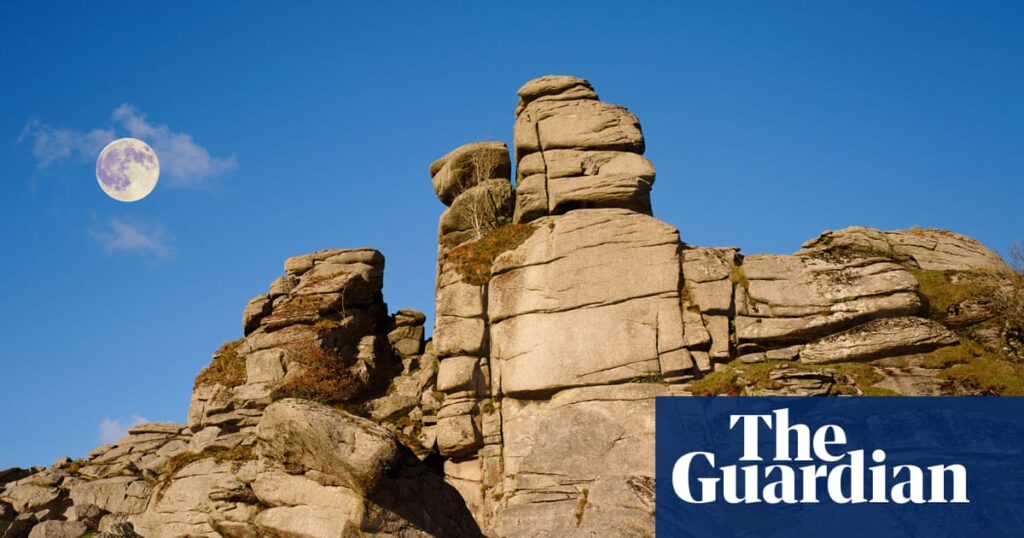TBluebells are starting to bloom along the Dart Canyon, creating a faint purple mist under the twisting oak trees. I’m on the way to Luckey TorThe rock stack is one of Dartmoor’s best-kept secrets. It sits on the riverbank, cloaked in vegetation, like Sleeping Beauty’s Castle. This is not an easy walk. As I continue to descend into the gorge the path becomes less and less clear. The final approach to tor requires clambering over huge mossy rocks and navigating large shelves of rock bordering the river.
Its first sight is memorable. Row Brook, a small river, runs through it like a moat. The tor dominates the valley, dwarfing all around it, and is set in a grassy clearing, which is a popular bivouac spot. It is situated in an unusual place. Most tors dominate the landscape for miles, without trees, at the top of a hill. Luckey tor is hidden in Dart valley’s folds and is covered in foliage in the summer. It feels like a secret world when you discover it.
The tor is just one of the hundreds of tors on Dartmoor. (The exact number is in dispute). The name derives from a Celtic word twr It is a term for a large rocky outcrop which rises abruptly above the surrounding land. They are 280 million-year-old natural monoliths that erupt like stone beings from the moor in all kinds of shapes and sizes. They look like castles or creatures. Vixen Tor is the home of numerous myths, legends and stories. Vixiana the witchThe devil lives at Dewerstone, and in many other places. Old Crockern is “the gert, old spirit of moor”, who lives near Crockern Tor.
In the early guides to Dartmoor, they called these rocks tors because they thought they were worshipped as idols by the druids. In 1793’s Historical Views of Devonshire, Richard Polwhele wrote: “In the druid ages, stones of various shapes were consecrated to religion … They prostrated themselves before the rudest … And wherever we find stones, which are at the same time massy and misshapen, there we look for the druidical gods. Vastness, in short, and rudeness were the characteristics of the druid rock-idols … “
Dartmoor’s idea of worshipping rock is not unique. Around the world, cultures such as the Sami and the indigenous Australians revere rocks. They are full of natural beauty and often located in high places. This may be because they connect us to the sky and the underworld. Our ancestors, who were better attuned with the landscape than we are, may have regarded tors as sacred. And we know, from the monuments they left behind – notably stone circles and stone rows, of which Dartmoor has some of the best examples in western Europe – that they practised some sort of faith.
Dartmoor has a sacred feel to it, and its rock stacks add to that. Since 2000, when we moved to Dartmoor, I have lived with them and the surrounding moorland. My children have played in them and I have walked through them. They have witnessed many important moments of my life, both happy and sad.
The idea of creating an illustrated book was born when I visited the Lake District. We chose the hand-drawn Wainwright guidebooks, which were compelling due to their subjective and intimate feel. They really reflected Alfred Wainwright‘s deep personal relationship with fells. I thought it would be great to produce a book like this for Dartmoor – with drawings by my husband, Alex, an artist. We chose 28 of the tors to visit and experienced a wide range of emotions at each. All of them have their own unique personalities: Blackingstone Rock with its surreal metal stairway going up the side with curly wrought iron handrails is a Victorian staircase to heaven. Hen Tor is miles away from anywhere and stands alone in a sea of rocks, like a cargo ship navigating granite waters. Watern Tor stands above the Scorhill stones in the basin, an extraordinary ice-carved work of art made from whirlpool Granite.
Dartmoor Tors Festival (23-25 May) was born out of our passion for the place. We wanted to share its enchantment and explore why we feel this way. Our artists, campaigners and archaeologists will join together to explore how we feel about wild landscapes. There will also be discussions and walks led by artists, archaeologists, and storytellers to sacred places such as stone rows and cairns.
We love this place because of the stone. That stone is what connects us to those who came before us. They worshiped it and it added a sense of spirituality to their lives. Stone is often perceived as being static, still and almost dead. The stone is definitely alive. However, it exists on a completely different timescale to us.
Sophie Pierce and Alex Murdin are the authors of Rock Idols Dartmoor Guide in 28 Tors (Wild Things Publishing, £14.99). To support the Guardian Order yThe following are some of the ways to improve your own ability. Copy from guardianbookshop.com. The first Dartmoor Tors festival, Runs from 23-25th May 2025


